Grand Cresta (KREH-stah)
The Lord of Might...
The largest land mammal found on Planet Thanged, this savage relative of the dainty unicorn has secured a place among the Thangien people as an unofficial mascot of passion, independence, and ferocity. Large enough to make a Clydesdale look small in comparison, the "mammoth beast-horses" found throughout Kundain and Tirmutua fear nothing and punish any slight with vengeance. Impossible to tame, foolhardy to ride, hazardous to incense, Grand Crestas permeate all aspects of Thangien culture from combat techniques, to architecture, to mythology.
Basic Information
Anatomy
Quadruped resembling Earth equines such as Belgian or Clydesdale. Possess dense bones and heavy musculature and large heavy hooves. Characteristic long bony crest extends backwards over the neck starting with a ridge of cartilage at the nose before extending back into a sharp crest of bone.
Biological Traits
Cresta mares are distinguished by their slighter build and shorter horns, 8-10 inches as opposed to stallion's 24 inches. Crestas have a well-known rivalry with the airborne gherfen but suffer the greatest casualties from each other with rut duels between mature stallions resulting in fatalities and mare births carrying a high risk of injury or death in the delivery process. Mares are less aggressive but by no means docile.
Genetics and Reproduction
Cresta mares carry young for roughly half a solar cycle, or 12 months Earth-time. Generally one stallion will preside over a herd-or "harem" of anywhere from 12-24 mares. Highest cause of mortality among mares occurs from abnormal births, namely if the foal emerges from the wrong direction, causing the nascent horn to damage the birth canal.
Growth Rate & Stages
Crestas attain adulthood at two solar cycles, or four years Earth-time. Fillies set out to join other harems while colts aspire to usurp their sires for control of the harem. A newborn's horn is roughly the length of a human index finger, and while not fully sharp, is still comprised of bone at its core.
Ecology and Habitats
Being strict herbivores, Crestas range all throughout Kundain and can even be found foraging Tirmutua for its variety of fruit.
Dietary Needs and Habits
Generally not picky eaters, capable of eating anything and everything from the sweetest grass to the roughest brambles. They are not completely immune to indigestion and are quick to seek out wild Richtho bushes for relief. While tree bears will ravage trees in search of insects or fruit, Crestas will hook their horns around small trunks and shake loose any produce be it nuts or fruit. They can dig root tubers from the ground with their large hooves. They do not compete with other herbivores for food but will not accept food offered from a human.
Biological Cycle
Due to the temperate climate, Crestas do not gain a winter coat but their high metabolism allows them to weather rare periods of extreme cold such as the Dread Winter of the previous Solar Swap. Their horns are firmly affixed to their skulls and do not shed like deer. They are primarily diurnal and can sleep standing or reclining but display some crepuscular habits such as during duels.
Behaviour
Despite their reputation for passion and ferocity, Crestas are generally calm in their day-to-day lives with the exception of rut between stallions. Gherfen are their only known native predator but the success rate against mature adults is fairly low, leading to gherfen targeting foals in an attempt to carry them off and drop them to the ground from on high. Although they cannot be domesticated, they tend to treat other land creatures indifferently unless provoked, and on rare occasions, will even behave in an almost altruistic fashion, rushing to intervene in a hazardous situation. A human can approach a Cresta cautiously, but attempting to pet it will almost always result in serious injury.
Cresta stallions in rut will emit vocalizations that are said to sound like a revving gas-powered chainsaw while mares make high-pitched cries like a zebra. Mature stallions will engage in rut duels to secure leadership of a harem of mares. The duel is preceded by furious stomping of the ground with their large hooves then combat engaged through the slashing of horns and swinging of necks. A loss always results in death and the victor will prance and strut to demonstrate his superiority. The victor and his harem will run off into the night while the loser is left to bleed out for vitreelas.
Ki Ki Crol, Rona had once described Grand Crestas as ‘mammoth beast-horses’. That sounded somewhat redundant to Brit, but looking upon the herd of creatures congregating in the forest, the name actually seemed quite fitting. Grand Crestas looked like a cross between a dinosaur and a draft horse, averaging six feet at the shoulder with thick powerful limbs and large hooves. Their tails hung down in waves of curly silky wisps, and they lacked manes, but they all sported the characteristic great bony crest from which they got their name. For the males, the crests looked like sharp scythes sloping backwards over their thick necks. Females sported shorter crests with a narrower point. Their coats ranged from white to gray with some spotted patterns. “Looks like a duel going on. Herds are called harems, since one alpha male presides over all of the females. Every so often a younger male will challenge the lead stallion for control. This old fellow looks like he has years of fights under his belt, but this younger chap seems strong and has more energy. It’s hard to see who’ll win.” As Cye spoke, the opposing stallions taunted each other with guttural snorts and stomped their hooves in a way resembling the Meteor Hoof technique. Thangiens claimed the Pegasi had adopted the technique from these savage relatives. The old stallion reared up and lashed out with his forehooves, instigating the fight. The young stallion bobbed his head and jerked up sharply, trying to pierce the old stallion in the chest with his bony crest. The old stallion knew better and veered to the side, and they went back to posturing briefly, mimicking the Pegasi’s war-dancing. Their bodies gleamed with sweat in the moonlight as they lunged again. The way they tossed their heads reminded Brit of dueling giraffes, except giraffes didn’t have sharp foot-long bony crests. The old stallion jerked his head to one side, hooking his crest against that of the young stallion, and tossed him to the ground. He began stomping the young stallion in the neck. The young stallion roared in protest and rolled to the side, thrusting towards the old stallion and piercing him in the neck. Brit gasped and looked away, and Cye put an arm around her shoulder and pulled her close. The old stallion let out a gurgling wail before collapsing to the side. The young stallion rose to all fours and nudged the unmoving body with a hoof before bobbing his head and stamping in triumph. He pranced over to the waiting harem and moved in a circle, bobbing his head and waving his crest. The mares let out piping yelps reminiscent of zebras, nodding in approval. With a roar, the stallion signaled the harem to depart, and they galloped out of the clearing. The lifeless body of the old stallion remained in the blood-soaked clearing.
Additional Information
Social Structure
Grand Crestas travel in harems with one alpha male and a dozen to two-dozen females. Younger stallions are tolerated until the time comes that they seek to challenge the alpha for leadership. Most of the time the incumbent stallion wins due to superior strength and experience, but on occasion can be usurped with cunning and a well-placed strike. Rather than being driven out by irritable mares, fillies will migrate on their own to seek out a different herd, presumably in an effort to avoid inbreeding.
Crestas do not seem very sympathetic toward their dead with harems abandoning the corpse of a fallen alpha or deceased pregnant mares to vitreelas.
Domestication
The first attempt to tame and domesticate a Grand Cresta ended in such a spectacular disaster as to surprise the Goddess of the Forge, Eyurodin. Subsequent efforts have ended in failure leading many to believe Crestas either lack the intelligence to interact with humans or are simply too fiercely independent.
Uses, Products & Exploitation
Cresta bones when picked clean by vitreelas and insects and bleached by the Twin Suns are prized by Freelanders for everything from tools to adornment. An intact skull is used as a sword with an edge powerful enough to rival dererium. Hide from an unspoiled carcass can be skinned and cured for clothing. Hooves can be hollowed, polished, and coated with resin to use for bowls or canteens. Thangiens respect Grand Crestas by leaving them at peace. Freelanders honor them by making sure no bone goes to waste.
At each major gate in the walls of Bainshaebo stand two towering stone statues in the stylized likeness of a Grand Cresta. Crestas can be depicted in everything from tapestries, stained glass, mosaics, bas reliefs, sculpture, and heraldic devices. Pillars in the colonnades of the Riders Citadel are adorned with stylized Cresta heads at the base and crown. Sometimes a Cresta is portrayed with a backward-pointing spiral horn signifying its relation to unicorns.
Facial characteristics
It is thought the triangular style of eyes used in Thangien artwork originated with the Grand Cresta due to the shape of their brows. Expressions are difficult to gauge due to their lack of earlobes. A ridge of cartilage extends from between the eyes at the base of the horn to just above the muzzle, giving the horn the appearance of extending all the way down the middle of the face.
They sport a mix of short fine hairs and long coarse hairs on their chins and the top of the nose. Sometimes called "chin whiskers", these hairs do not seem to serve any function in finding food or detecting threats, though some speculate Crestas are able to sense subtle differences in electromagnetic fields and ultrasonic frequencies. This remains a theory at best.
Geographic Origin and Distribution
Kundainian Plains, Tirmutua, and shores of freshwater such as the Winding White and Lake Danaetanera. Crestas avoid the Northern Ring due to the biting cold and the Southern Salt due to the unstable ground and risk of hoof-rot. They can swim if necessary but prefer to avoid immersion. Even during storms Grand Crestas will go out of their way to avoid entering the Eastern Jungle, but not because they fear the Natives. If there is one other beast even they would not cross, it would be the enigmatic pegotaur.
Average Intelligence
Grand Cresta intellect has been a subject of debate as long as men have dwelled on Thanged. Some contend they lack the capacity to understand humans while others counter they simply have no interest in interaction. Results of the "mirror test" are inconclusive as Crestas will headbutt the mirror almost instantly, seemingly in irritation. They definitely lack the empathtic capabilities of unicorns, pegasids, or pegacorns. They have displayed an aptitude for puzzle-solving and using their horns as tools such as cutting through insect mounds to reach roots beneath and scything tall grasses for easier access. Thangiens hold Grand Crestas in too high regard to keep them in captivity in either private enclosures or in the Dome of Mazzan, so in-depth study remains an untapped field.
Perception and Sensory Capabilities
Crestas lack external earlobes, instead relying on inset tympanic membranes. Their hearing is surprisingly acute, able to determine the direction of an incoming diving gherfen and respond quickly enough to intercept. Good peripheral vision. Blind spot at the back of the head. Long coarse hairs on their chin and nose do not seem to serve any sensory function.
Symbiotic and Parasitic organisms
Tree bears often damage live trees in pursuit of insects, but Crestas have demonstrated an easier method by thumping trunks with their horns and necks, both shaking loose produce from boughs and startling insects from their burrows and to the surface. They can also easily tear apart insect mounds with their hooves and horns, while tree bears simply rely on their tongues and claws to lap up stray insects. Pei monkeys can sometimes hitch rides on the shoulders of Crestas without incurring their wrath, presumably in exchange for dislodging persistent pests in difficult-to-reach locations.
Gherfen, the "Helmed Hawks" remain their greatest rival/predator while vitreelas are quick to descend upon the carcass of the loser in a rut duel or a mare perished from childbirth. Sttanavoseni make their burrows deep enough to avoid cave-ins caused by trampling herds and having an errant hoof breaking through the ground entirely.
Civilization and Culture
History
Men have known about Crestas since they set foot upon Thanged with the earliest aboriginal Freelanders revering Grand Crestas as totem beasts. Believed to either be distant cousins of unicorns or a precursor, Crestas have dwelled on Thanged for hundreds of thousands of years.
After the completion of the walls of Bainshaebo, a farmer attempted to raise a foal by hand and domesticate a Grand Cresta as a beast of burden. The Cresta took slight to this and famously smashed a hole straight through Bainshaebo's western wall, forcing Roth to abandon her original plan of limiting the people to the interior of the walls.
Among her many legendary exploits in her youth, Queen Danaetanera III is credited with being the first and only Thangien to win the allegiance of a Grand Cresta through friendship and the virtue of her pure heart and warrior spirit. Excerpts from her daughter and successor Queen Alahaedra's memoirs contest this, however, insisting it is merely colorful embellishment by overly-imaginative playwrights and llaudaind. Crestas are incapable of telepathic interaction with either unicorns, pegacorns, or Pegasi.
Common Myths and Legends
The Cresta and the Imp
One of the oldest-known stories from the earliest existence of men on Thanged. Animal fable detailing a challenge issued by an ominous figure and his demonic minion and an appeal by the beasts of Thanged for Cresta to intervene on their behalf.The Cresta and The Wheel
Mostly historically-accurate account of the first attempt to tame and domesticate a Grand Cresta. Origin for the signature blade-breaking technique the Cresta's Wheel of the School of Rait'chian and the matching deflection technique the Cresta's Kick.A herd of horse-like beasts with long, curved crests protruding from the back of their heads gathered at the shore of a river. Even the youngest-looking of the creatures stood taller than Rowen at the shoulder.
“They are fierce and powerful, but they cannot be tamed by any Thangien. They are wild, and do not understand the intricacies of friendship and loyalty men express; the bloody oath and the grim pact. Still, they are noble and proud. Every day they live with passion, and every danger they meet with vengeance! They taught us that passion is as much a part of being a warrior as purpose, and that there is beauty in the battlefield.”-Ki Ki Crol, Rona
Scientific Name
Equus gladiocorn
Origin/Ancestry
Equus
Lifespan
5-20 solar cycles (10-40 years Earth-Time)
Average Height
6-7 ft at the shoulder, or 18-21 hands.
Average Weight
1500-3000 lbs
Average Length
9-12 ft.
Average Physique
The bulk of a Grand Cresta easily rivals or surpasses that of Earth draft breeds such as Clydesdale, Belgian, and Shire. Their dense bone structure supports their great stature, but their metabolism requires near-constant grazing. While they do not have to store fat for cold periods, they sport a thin layer of subcutaneous fat for emergencies, enhancing their already statuesque appearance.
Body Tint, Colouring and Marking
Coats range anywhere from white to gray with slight tints of blue and occasionally spotted patterns. They possess no manes but their tails appear as a cascade of several springy, wispy locks. Fur is generally short and smooth with longer hairs above the hooves, but not quite as long as a Clydesdale's. Brown and black coats have been spotted on occasion but are very rare.
Geographic Distribution
Related Myths
She opened her mouth to speak then paused and grimaced when she heard a sound that cut through the pristine quiet of the lake. “…Is…Is that a chainsaw?” Cye glanced at her then frowned and glanced from side to side, trying to analyze the sound. His expression lightened. “No…but I think I know what it is. This way. You want to see a Grand Cresta?”
A lone Cresta foal had become separated from its mother, and the Black Unicorn approached swiftly. All of a sudden a large form intervened, kicking up dust and giving the foal enough time to scramble to its feet and trot away. The Grand Cresta stallion had blood caking its crest, only a couple days old. It’s him! It’s the same one!! Cye recognized the stallion as the one who had wrest control of the harem from the old leader in that bloody duel. The stallion stamped his hooves, challenging the Black Unicorn, who seemed unfazed by the show of might.


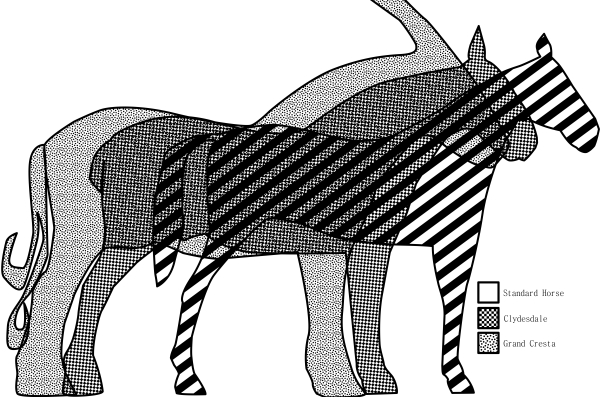
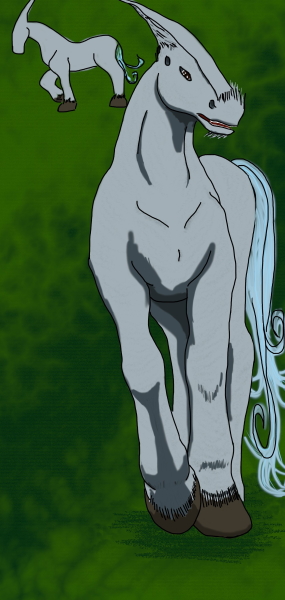
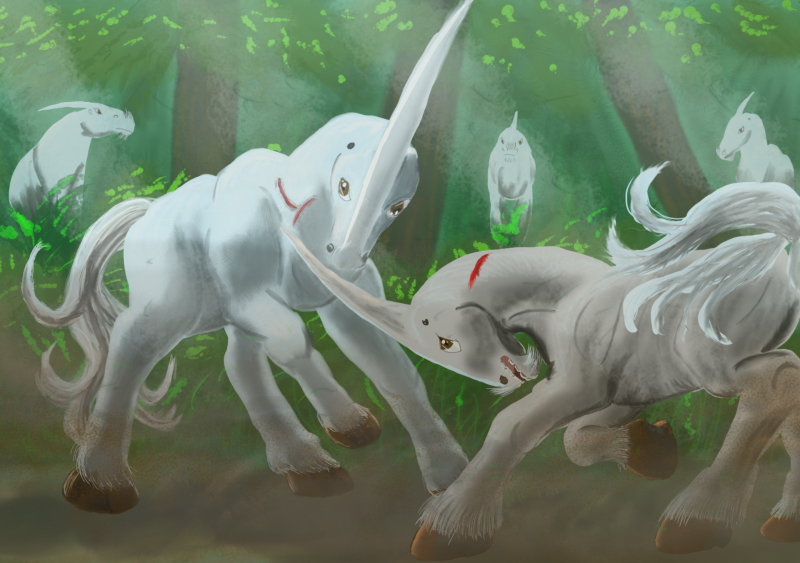
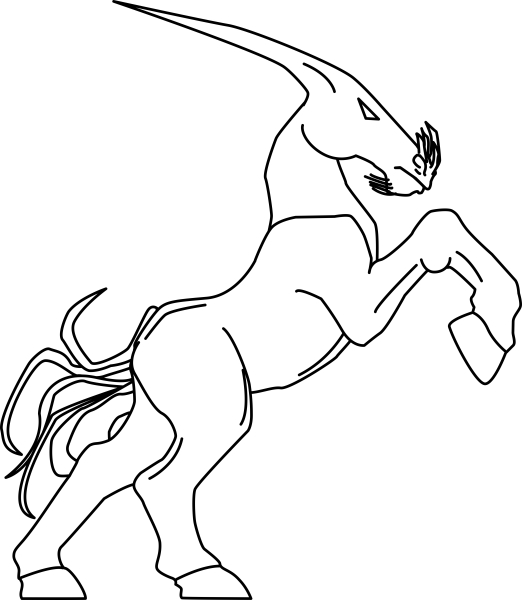
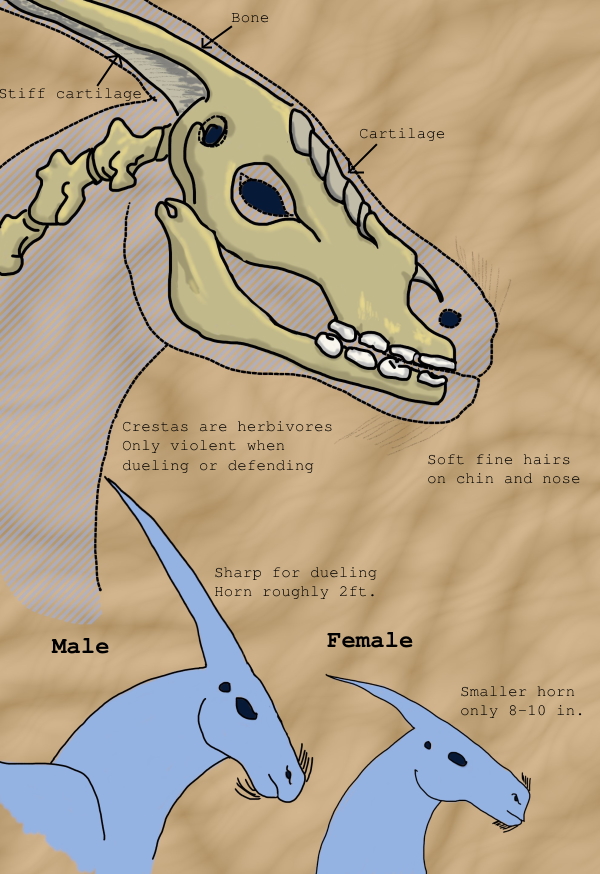

Comments